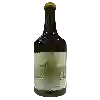
Winery Xavier ReverchonVin Jaune Côtes du Jura
This wine generally goes well with poultry, mature and hard cheese or mushrooms.
Wine flavors and olphactive analysis
On the nose the Vin Jaune Côtes du Jura of Winery Xavier Reverchon in the region of Jura often reveals types of flavors of non oak, oak.
Food and wine pairings with Vin Jaune Côtes du Jura
Pairings that work perfectly with Vin Jaune Côtes du Jura
Original food and wine pairings with Vin Jaune Côtes du Jura
The Vin Jaune Côtes du Jura of Winery Xavier Reverchon matches generally quite well with dishes of spicy food, mature and hard cheese or poultry such as recipes of chicken with green olives, savoyard tarts or spaetzle.
Details and technical informations about Winery Xavier Reverchon's Vin Jaune Côtes du Jura.
Discover the grape variety: Chardonnay
The white Chardonnay is a grape variety that originated in France (Burgundy). It produces a variety of grape specially used for wine making. It is rare to find this grape to eat on our tables. This variety of grape is characterized by small bunches, and small grapes. White Chardonnay can be found in many vineyards: South West, Burgundy, Jura, Languedoc & Roussillon, Cognac, Bordeaux, Beaujolais, Savoie & Bugey, Loire Valley, Champagne, Rhone Valley, Armagnac, Lorraine, Alsace, Provence & Corsica.
Informations about the Winery Xavier Reverchon
The Winery Xavier Reverchon is one of of the world's greatest estates. It offers 20 wines for sale in the of Côtes du Jura to come and discover on site or to buy online.
The wine region of Côtes du Jura
Côtes du Jura is a regional appellation in the Jura wine region of eastern France. Introduced in 1937, it is arguably the largest appellation in the region in terms of geographical extent. In terms of quantity, it is the second largest after Arbois">Arbois. While the vast majority of Jura wines are produced in the Northern half of the region between Etoile and Arbois, the Côtes du Jura catchment area extends some distance to the South.
The wine region of Jura
The Jura is a small wine region in eastern France that is responsible for some very special and traditional wine styles. It is close to the Swiss Jura, but quite distinct from it. Wedged between Burgundy to the west and Switzerland to the east, the region is characterized by a landscape of Wooded hills and the winding topography of the Jura Mountains. The Jura vineyards cover just over 1,850 hectares, forming a narrow strip of land almost 80 km Long from North to South.
The word of the wine: Dismantling
After devatting, the pomace is removed from the tank. If this operation is carried out manually, it is important to ventilate the vat well to avoid the risk of accidents due to the presence of carbon dioxide.














